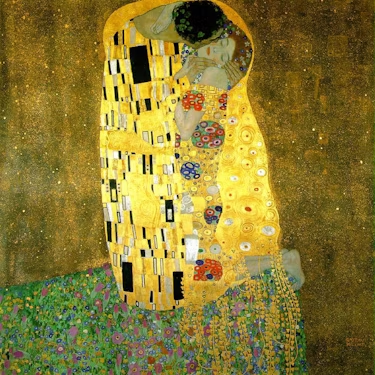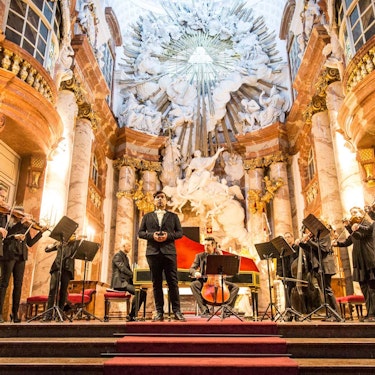More about: Vienna in 2 Days: everything you need to know
The capital of Austria has a long history behind it. The prestige of past centuries is reflected in its squares and buildings that stand out for their elegance and majesty.
If you have booked a plane ticket to Vienna you have chosen well, I am sure you will want to repeat. This article reveals what to see and do in Vienna so you can make the most of your stay.
Day 1: Vienna's must-sees
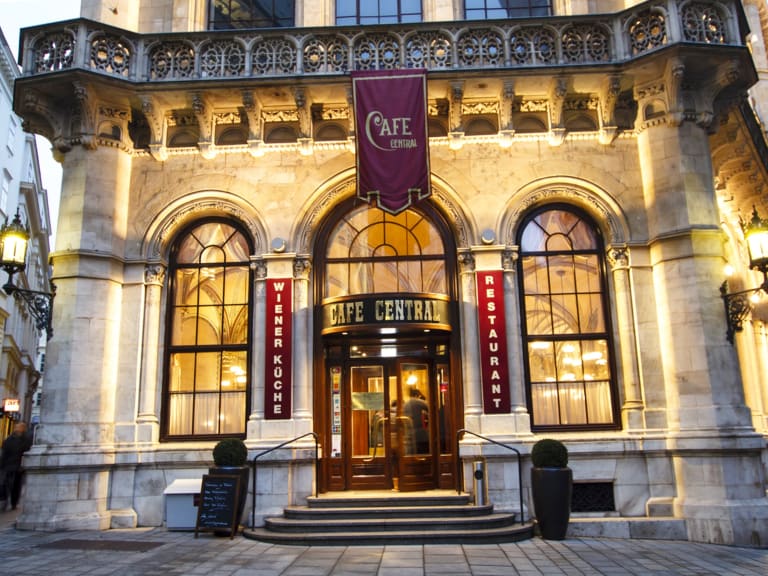
Before you start touring the city, there's nothing better than a good breakfast. Remember that you are in Vienna and it never hurts to start the day with a delicious sacher cake.
Breakfast in style
Our route starts at 14 Herrengasse. We are in the heart of Vienna, within walking distance of the Daun-Kinsky Palace and the Church of the Friars Minor (Minoritenkirche).
On this elegant avenue is the Café Central, a landmark of the capital. Its vaulted ceiling is due to the building's former use. Before 1860 it housed a bank designed by Heinrich von Ferstel, one of the best-known architects of the time.
It has several options for breakfast. The Viennese style offers an espresso with frothed milk, homemade rolls and butter. For something more substantial you can opt for the imperial breakfast that includes a glass of cava, coffee, orange juice, smoked salmon, croissants and much more. You can also opt for something sweet. Their counter displays an extensive collection of cakes that look like works of art.
- Open daily from 7:30 am to 10:00 pm (Monday to Saturday) and from 10:00 am to 10:00 pm (Sundays and holidays).
Visit the fine Habsburg retreat
Schönbrunn was the summer residence used by the imperial family of Austria. It is undoubtedly the finest palace in Vienna and a symbol of class and elegance. Its fame is due to Maria Theresa, who commissioned Nikolaus von Pacassi to remodel it. After a few years, the architect gave the empress a jewel of Austrian rococo.
To get there you can take the subway in Herrengasse (a short distance from the Central Café) and get off at the stop Hütteldorfer Straße. Once there you just have to take streetcar line 10 and get off at Schloß Schönbrunn. You will arrive in front of the monumental entrance.
Visiting Schoenbrunn Palace is easy thanks to the audio guides that you will find inside. After visiting its superb halls I recommend a stroll in its baroque gardens. The green area includes a large labyrinth and the panoramic terrace of the Gloriette building.
Stroll in front of the town hall

Once you have finished your visit, you can go the other way around (streetcar and metro) and get off at the Volkstheaterel stop. A few minutes walk away is the Rathauspark, a symmetrically designed park that acts as a cornice to the town hall (Rathaus).
It is a Gothic style building topped by a tower that makes it look like a cathedral. It was erected between 1872 and 1883 following the project of Friedrich Schmidt, the architect who restored the Stephansdom, the Cathedral of Vienna.
The municipality organizes guided tours that touch on its main rooms: the Council Chamber, the two Coat of Arms Halls, the Grand Staircase and the Arcade Courtyard, among others.
Free audio guides are available in several languages, including Spanish. A Christmas market has been held in front of the town hall since the end of November.
Marvel at the Parliament
Just a few meters from the town hall is the political heart of Austria. The main entrance is preceded by a splendid fountain dominated by the statue of Pallas Athena.
The goddess of wisdom holds a spear in her left hand and the goddess of victory Nike in her right. It is made of marble with gold details. Behind her silhouette is the Parliament, a Greco-Roman style building designed by Theophil Hansen.
He was a famous architect and before taking office he had already directed the construction of the Academy of Fine Arts (Schillerplatz 3) and the Museum of Military History (Arsenal 1).
The decision was a wise one, as he designed a splendid building embellished with statues of Thucydides, Herodotus and Julius Caesar, among others. The Parliament itself organizes guided tours and if you are interested you can attend a plenary session.
Enter the stables of the Spanish Riding School

Do you know the Lipizzaner horses? These splendid equines originate from the town of Lipizza (today a town in Slovenia) and were introduced to the Viennese court by the Spanish Emperor Charles II.
According to enthusiasts, they are the result of a mixture of Spanish, Arabian, Neapolitan and Czech specimens; what is certain is that they are very elegant and at the same time ideal for dressage.
The Spanish Riding School preserves the tradition and organizes horse shows that are worth seeing. These horses are very intelligent and are trained to perform complex movements with grace.
The cheapest is a ticket for the trainings with exercises for relaxation, refinement and strengthening of muscles. They take place from 10:00 to 11:00 while the cost is around 15 €.
Dinner at one of the best restaurants in the world
In caseyou are traveling in spring or summer I advise you to book a table at Steirereck, a two Michelin-starred restaurant in the heart of the Stadtpark, Vienna's City Park.
Getting there from the Spanish Riding School is very easy, just take the subway (line 3 from Herrengasse) and get off at the Stubentor stop.
As you come up on the surface you will see the Wienflussportal, an Art Nouveau bridge over the Vienna River. You can't confuse it with the Danube as it is much less abundant and flows placidly along the garden.
I recommend a stroll before sitting down for lunch, Stadtpark is an oasis of tranquility dotted with classical monuments. An honorable mention deserves the statue of Franz Schubert and the golden figure of Johann Strauss immortalized with a violin in his hands.
The restaurant is housed in a modern building with large windows and offers traditional Austrian dishes with a French touch. Indeed, Steirereck's chef - the famous Heinz Reitbauer - trained with Alain Chapel, the creator of the Nouvelle Cuisine.
From him he learned a passion for ingredients so much so that the mushrooms served are personally harvested in the Vienna Woods. The menu is seasonal and the reviews are excellent. Open Monday to Friday from 11:30 am to 2:30 pm and after 6:30 pm. Reservations well in advance are recommended.
Day 2: the cathedral and highlights

Are you ready to discover the city's other charms? This second day begins in the heart of Austria's capital, right at the foot of its most famous church.
Start the tour at Stephansplatz
This is the heart of Vienna and home to the building most beloved by the Viennese: St. Stephen's Cathedral (Stephansdom). "Steffl" - so it is nicknamed by the locals - is an imposing Gothic church with Baroque details.
On the roof, colored tiles recreate the double-headed eagle of the Austro-Hungarian Empire and the coat of arms of the city. You can visit the interior, the main tower and the catacombs.
Before going up you can treat yourself to a panoramic breakfast. On the square itself is the Boutique Hotel am Stephansplatz, which enjoys a splendid view of the Viennese temple.
Its café is named after the Spanish tenor Giacomo Aragall and is an ideal choice for an energetic start to the day. From 6:30 to 10:00 (11:00 on weekends and public holidays) you can enjoy a breakfast buffet with croissants, fruit, hot and cold dishes, freshly squeezed juice and much more.
Admire the Church dedicated to St. Charles Borromeo
This majestic temple was built to thank God for saving Vienna from a plague. In the 18th century, Europe was plagued by a Black Death epidemic that fortunately spared the capital. The Holy Roman Emperor Charles VI commissioned the architect Johann Bernhard Fischer von Erlach and decided to dedicate the church to the bishop of Milan, Charles Borromeo.
The twin columns on the exterior refer to both the Temple of Solomon and the Pillars of Hercules. Indeed, Charles V had chosen the latter as the adopted symbol of the Holy Roman Empire.
Ifyou travel to Vienna in December, you will be able to listen to live gospel artists or classical music concerts. It is an ideal occasion to admire its interior comfortably seated.
Feel like an aristocrat at the Belvedere Palace
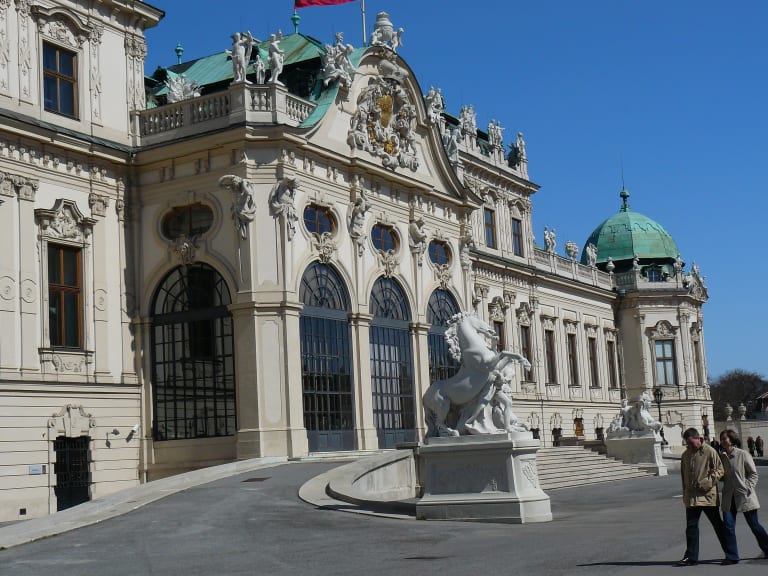
The Belvedere Palace was the summer residence of Prince Eugene of Savoy. He was an art lover and commissioned the architect Johann Lukas von Hildebrandt to build this splendid Baroque building.
The ensemble consists of two parts - Upper and Lower Belvedere - and is surrounded by splendid gardens. A large pond in front of the façade reflects its silhouette adding a romantic touch to the surroundings.
Inside it houses an art collection ranging from the Middle Ages to the post-war period. Its greatest attraction are the paintings of Gustav Klimt, one of the most prominent members of the Viennese Secession, a branch of modernism. His famous works "The Kiss" and "Judith" can be found here along with the iconic oil on canvas "Napoleon Crossing the Alps" by Jacques-Louis David and other paintings.
Outside is also the Orangerie, a greenhouse converted into a cultural space. The Belvedere Palace has so many different spaces that the opening hours of the Belvedere Palace differ from one space to another. I recommend you to read the dedicated article to organize your visit.
Discover an art nouveau masterpiece
Once you have finished your visit to the aristocratic residence, take the streetcar (line O) and get off at the Marxergasse stop. In less than ten minutes you will arrive in front of the Hundertwasserhaus, a residential block that winks at Gaudí's creations.
The building looks like something out of a fairy tale and stands out for its irregular facade (windows, balconies and other decorative elements do not follow the same pattern) and the cheerful pastel colors. It was built between 1983 and 1985 thanks to the collaboration between two architects: Josef Krawina and Peter Pelikan.
Next to the residence you will find a shopping center known as Hundertwasser Village. It has the same style of the nearby houses and is the ideal place to buy an original souvenir. It is open every day of the week from 9:00 to 19:00.
Stroll through the second largest amusement park in Europe

To reach the penultimate stage of the day you will have to cross the Danube Canal, a branch parallel to the great river. In just over 15 minutes you will reach the Prater, the most famous green area of the city. If you are traveling with children, this is a highly recommended option.
You can climb the big Ferris wheel (Wiener Riesenrad) and have fun with them in the amusement park.
Climb the Donauturm
From the Prater, take the Imperial Bridge (Reichsbrücke) and reach the island in the middle of the Danube. On this stretch of land stands the Donauturm, the only place where you can enjoy a 360° view.
The tower has watched over Vienna since the 1960s and has become a true symbol of the city. It is a balcony overlooking the Danube, the Cobenzl vineyards and the Vienna Woods (Wienerwald). Nearby you can see the skyscrapers of Donau City, an office and shopping district.
If you travel in winter, you don't have to worry about the cold: a glass terrace allows you to enjoy the view in all weather conditions. A high-speed elevator will take you up to the summit in just 35 seconds! However, on days with strong winds, the speed is reduced to avoid swaying.
Donauturm is open every day of the week from 10:00 to 22:30. The last ascent takes place at 23:00.
Is it worth seeing Vienna's surroundings in a two-day stay?
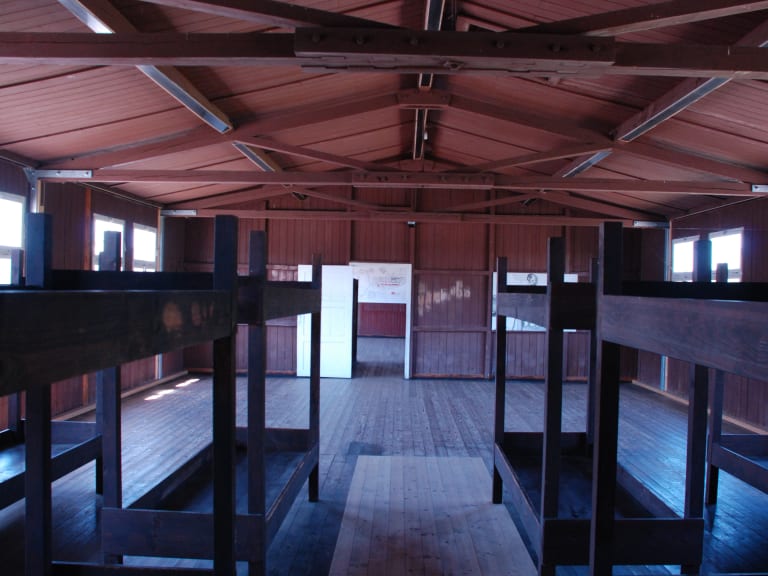
In my opinion, two days is the minimum time to discover Vienna. It was the capital of a great empire and its streets are dotted with charming buildings, parks and museums.
However, if you are traveling in summer and want to escape the heat or want to see a bit more of Austria, you have plenty to choose from. In the vicinity of Vienna, the spa town of Baden, Bratislava or the Mauthausen concentration camp are worth a visit.
Another interesting option is a river cruise on the Danube. The most recommendable destination is the Wachau Valley, a natural enclave declared a World Heritage Site by Unesco. It is a wine region embellished by traditional villages and lush nature. The ships usually depart from a central location in Vienna and stop at the following locations:
- Krems, a medieval town at the confluence of the Krems and Danube rivers. Its icon is the Steiner Tor, a gate originally built in the 15th century and remodeled in the Baroque style. It is the most important center of Lower Austria's wine-growing region.
- Ruins of Dürnstein Castle, what remains of a 12th century fortress. The famous King Richard the Lionheart was imprisoned within its walls for just under a year. From here one enjoys a magnificent panorama.
- Stift Melk, a Benedictine abbey on the banks of the river. It has an extraordinary library and very elegant gardens. Please note that cruise ships reach the village of Melk only in summer.

